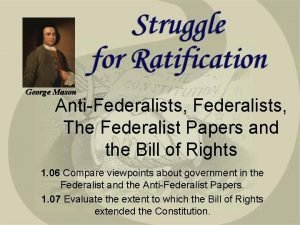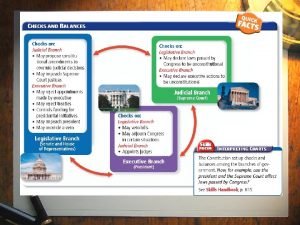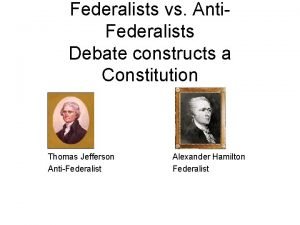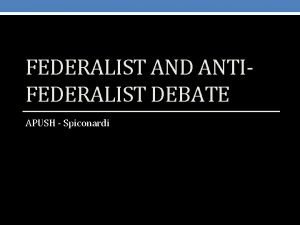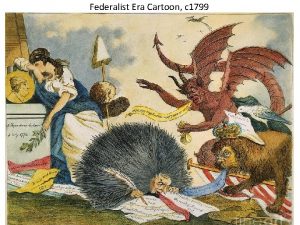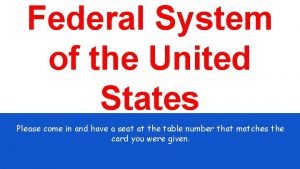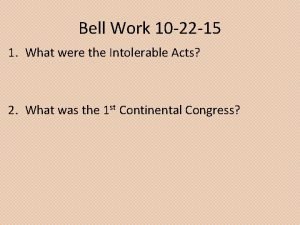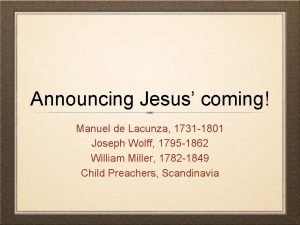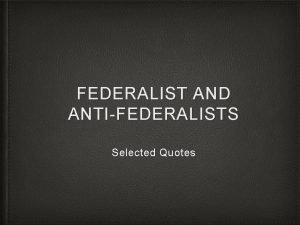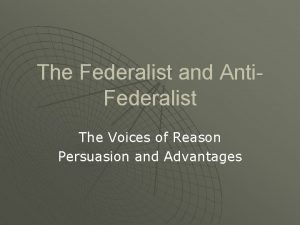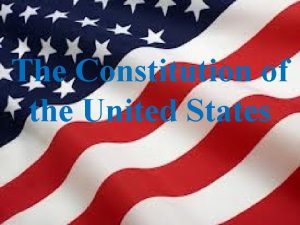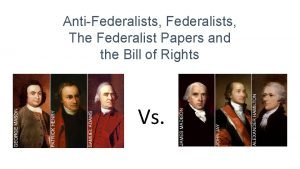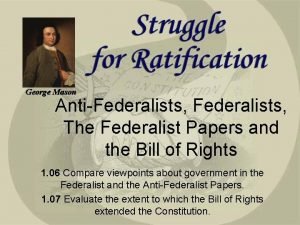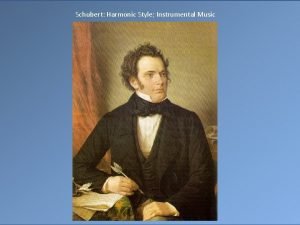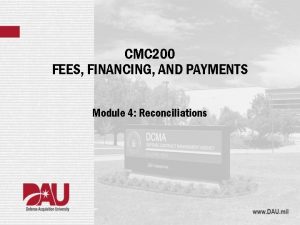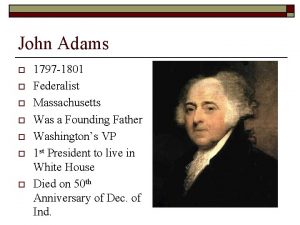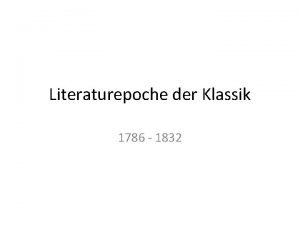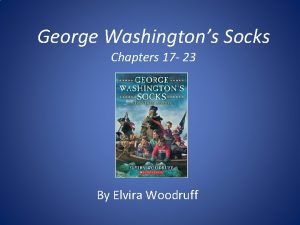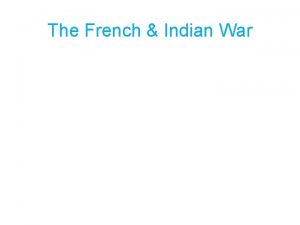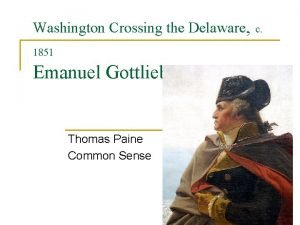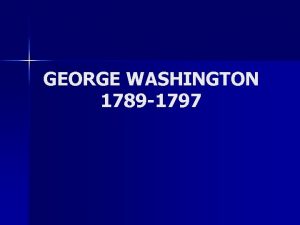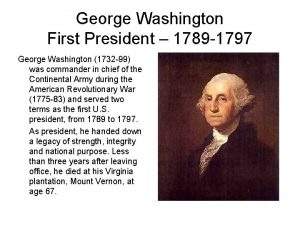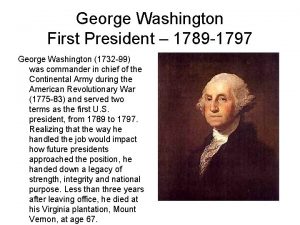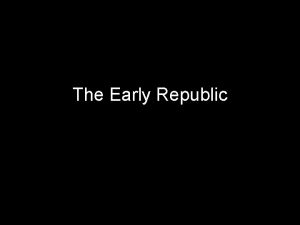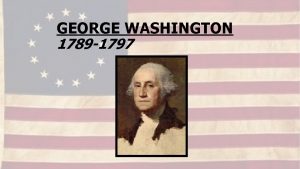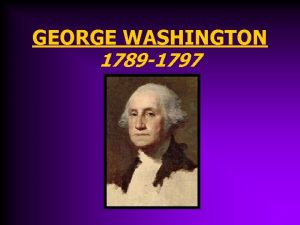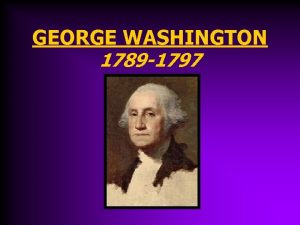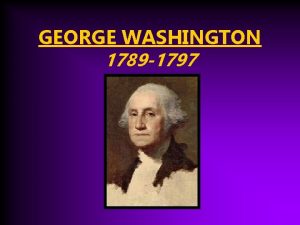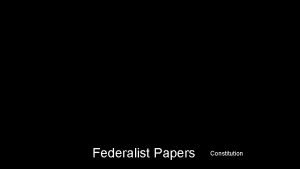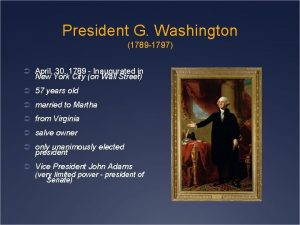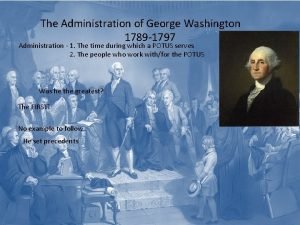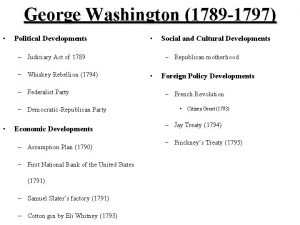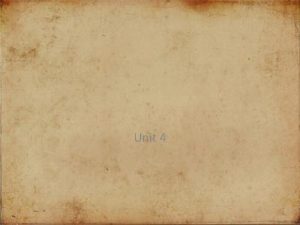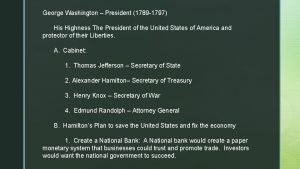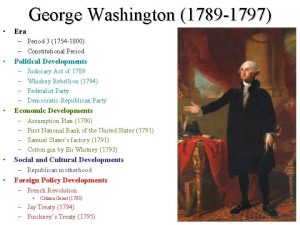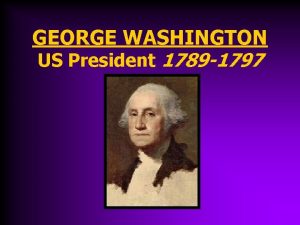GEORGE WASHINGTON 1789 1797 Federalist Papers late 1780
























- Slides: 24

GEORGE WASHINGTON 1789 -1797

Federalist Papers (late 1780 s) • The Federalist Papers consist of eighty-five letters written to newspapers in the late 1780 s to urge ratification of the U. S. Constitution. With the Constitution needing approval from nine of thirteen states, the press was inundated with letters about the controversial document.

Federalist Ideas • • • Separation of Powers Checks and Balances Powers to the states Bill of Rights Veto Power • Had little impact on the people, but did help guide the building of the Constitution.

George Washington’s Presidency • April 30, 1789 Washington (Virginia) is inaugurated (sworn in) as President. John Adams (Mass. ) becomes the Vice. President.

George Washington’s Presidency • Washington establishes many governmental precedents. PRECEDENT: an example that would become a standard practice. Can you name at least 2 precedents set by George Washington? ? ?

First Congress • Judiciary Act of 1789: 13 federal Court districts – 3 circuit courts, 6 supreme court justices, John Jay • • • James Madison: Speaker of the House Tariff Act of 1789: 5% duty on imports Bill of Rights 1 st: Freedom of speech & religion 2 nd: Right to bear arms 4 th: No unreasonable search and seizures 5 th: Due process clause, no self incrimination 7 th: Right to a speedy trial by jury

I. Establishment of the Court System Ø Federal Judiciary Act of 1789: passed by Congress. 1. Created an independent federal court system with the Supreme Court and lower level courts.

2. The U. S. Supreme Court is to have a Chief Justice and five associate justices. Currently we have 9 total justices. 3. Washington appoints John Jay as Chief Justice.

II. Establishment of the Presidential Cabinet A. The Constitution allows Congress to create departments to help the President – the Cabinet. B. The first Presidential Cabinet had four departments:

The First Presidential Cabinet 1. Secretary of War (Henry Knox) oversee the nation’s defenses.

The First Presidential Cabinet 2. Secretary of State (Thomas Jefferson) oversee the relations between the U. S. and other countries.

The First Presidential Cabinet 3. Secretary of the Treasury (Alexander Hamilton) to manage the government’s money.

The First Presidential Cabinet 4. Attorney General (Edmond Randolph) to advise the government on legal matters.

III. Hamilton’s Financial Plan NOTE: Alexander Hamilton believed that the federal government should be stronger than the state governments.

III. Hamilton’s Financial Plan A. Pay off the war debt to develop the trust of other nations for trade. B. Raise the federal government’s revenues through tariffs and taxes. TARIFFS – a tax on imported goods.

III. Hamilton’s Financial Plan C. Tariffs would… 1. encourage the growth of American industry (buy American-made). 2. raise money for the federal government.

III. Hamilton’s Financial Plan D. Create a NATIONAL BANK: 1. safe place to keep the government’s money. 2. can make loans to businesses. 3. would issue paper currency. 4. strengthen the federal government.

IV. Debate on Interpretation of the Constitution • STRICT CONSTRUCTION: only what the Constitution clearly states – favored by Jefferson and Madison. • LOOSE CONSTRUCTION: the Constitution should be flexible to meet the needs of the country (Elastic Clause) – favored by Hamilton and Adams. v Jefferson and Hamilton argue these points on the creation of the National Bank.

V. Major Events During Washington’s Presidency A. Battle of Fallen Timbers (1794) the American army defeats a confederation of Indians over tension in the Northwest Territory. • Treaty of Greenville (1795) 12 tribes cede much of present-day Ohio and Indiana to the U. S. government.

V. Major Events During Washington’s Presidency B. The Whiskey Rebellion (1794) PA farmers refused to pay the tax until the American army enforces it. This upholds the power of the new federal government.

V. Major Events During Washington’s Presidency C. The French Revolution (1789 -1793) the French people overthrow the French monarchy by executing King Louis XVI. • Neutrality – the U. S. would not side with any European country in wartime.


V. Major Events During Washington’s Presidency D. Pinckney’s Treaty (1795) Spain gave the Americans the right to freely travel on the Mississippi River and use the port of New Orleans.

VI. Washington Retires Ø Established the precedent of only a two-term presidency, which becomes the 22 nd Amendment in 1951.
 1797 - 1789
1797 - 1789 George mason quotes anti federalist
George mason quotes anti federalist Federalist vs anti federalist quiz
Federalist vs anti federalist quiz Federalists and anti-federalists
Federalists and anti-federalists Federalists vs antifederalists apush
Federalists vs antifederalists apush Federalist vs anti federalist cartoon
Federalist vs anti federalist cartoon Federalism cartoon explanation
Federalism cartoon explanation George washington vs king george iii
George washington vs king george iii Venn diagram george washington and king george iii
Venn diagram george washington and king george iii May 19, 1780
May 19, 1780 Edward irving
Edward irving Against the gods 1780
Against the gods 1780 Federalist quotes
Federalist quotes Anti federalist papers
Anti federalist papers The federalist papers
The federalist papers Anti federalist drawing
Anti federalist drawing George mason anti federalist
George mason anti federalist Gretchen am spinnrade melody
Gretchen am spinnrade melody Dcma form 325
Dcma form 325 John adams 1797-1801
John adams 1797-1801 Merkmale der weimarer klassik
Merkmale der weimarer klassik Curious george washington
Curious george washington George washington's socks study guide
George washington's socks study guide French and indian war
French and indian war Emanuel leutze
Emanuel leutze

